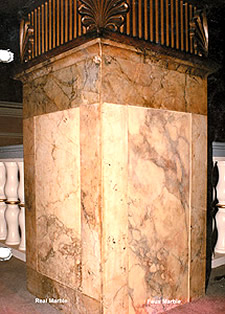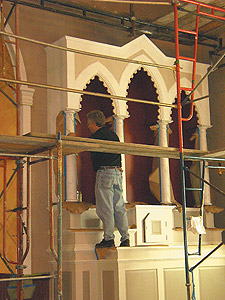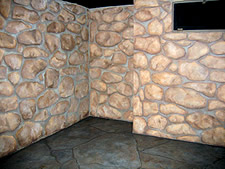 |
 |
| Top: Distressed cabinets; Bottom: Column, left side is real marble and right side is faux marble. |
...continued from previous page
Philip Emmerling, Emmerling Studio, Portland, Oregon
by John Strieder
. He works in ritzy new homes to make new kitchen cabinets look 100 or 200 years old. Or, he gilds a ceiling in silver leaf. Aluminum is cheaper and doesn’t tarnish, he notes, just as brass is sometimes an effective substitute for gold.
A rich client in the Southwest hired him to paint an authentic knotty wood grain on a pair of white plastic doors. The man could easily have afforded real wood, Emmerling notes. “He got off on the fact that I painted the doors to look like wood. It was fun for him.” Another project was to marbleize the columns on the second and third floors of the Portland Public Library. To help with marbleizing, he developed his own water-based propylene glycol, which he adds to water-based paint to slow drying time. “It just keeps a wet edge so I can manipulate it as much as I want,” he says. Sometimes, Emmerling really has to get his hands dirty. An architect invited him to install a faux stone archway in the master bedroom of a home built for Portland’s “Street of Dreams” home show. “They were talked into it for P.R. purposes,” he says. “The builder was on a tight budget.” Emmerling obtained some quick-dry Sheetrock mud compound, added water and sand, taped grout lines with half-inch tape, and started hand-molding faux rock. As the mud set, he pulled the tape away and softened the grout lines with his finger. He coated the work with two base coats of water-based primer, glazed it in four colors, accented each stone with an art brush, and painted the grout lines. The results? “Quite realistic,” he declares. “People walked by and thought it was stone.” Emmerling also does murals, and when he does, he often works with Paul Missal. They’ve collaborated on 15 or 20 projects in the past decade and a half. Missal, 64, is an accomplished art painter and a professor of drawing and painting at the Pacific Northwest College of Art in Portland. And he is effusive about Emmerling’s skills. “I think he is the expert in faux painting in Portland,” he says. “He’s a technician with paints. I know artistic things and what they do, but I don’t know commercial paints.”
 |
 |
 |
| Top & center : Faux marble columns; Bottom: Trompe l'oeil stones and slate floor. |
One of their first joint efforts was an 8-foot by 48-foot art deco mural painted in 1991 for the Island Shangri-La Hotel in Hong Kong. The mural, displayed in a swanky top-floor restaurant lounge, depicted a nightclub awash in 1940s ambiance, with long gowns, tuxedos, cigarette holders and lots of color. “It was done to suggest a classy atmosphere, upscale,” Missal says. “These (people in the painting) are people for whom money doesn’t matter.” The mural was painted in Oregon on canvas instead of on the wall itself. This has a practical side benefit, as Emmerling discovered with another joint project, a 5-foot by 35-foot still-life mural for the Hong Kong Hilton. The mural was hung in 1991. The Hilton was bulldozed in 1995. The piece got lucky. It was attached to the wall of the hotel with heavy-duty wallpaper paste — a firm but removable adhesive. The hotel’s restaurant manager was allowed to salvage the mural before the demolition, and hung it in a new restaurant only a block or two away. A Russian artist’s mural that shared the walls with the still life was not as fortunate. That mural was fixed to the wall with epoxy, and it was destroyed, Emmerling says. Emmerling and Missal also collaborated on a pointillistic mural for Portland’s Imperial Hotel that depicted the bridges of Portland using thousands and thousands of dots. And the two have painted murals for private homes. One, for a formal dining room, depicts an English hunt at various times of the day, from early morning preparations to the pursuit of the fox, then finally to the stabling of horses and evening church services. Missal describes Emmerling as a gentle perfectionist. “He’s easy to be around. He’s not big into tension and pushing. He communicates by showing. He doesn’t talk about it.” Indeed, just as Emmerling didn’t adjust his prices for Asian markets, he doesn’t worry much about variables such as the rising price of materials. “I get into doing what I do and what works,” he says, “and I stick with it.” 
|

